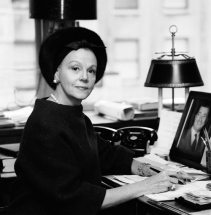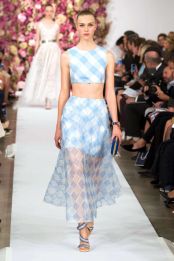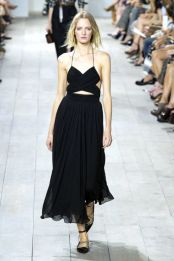Badgley Mischka, Marc Jacobs, Micheal Kors, and Zac Posen are all names that often come to mind when someone thinks of American designers. Thanks to Mercedes-Benz New York Fashion Week, both known and on-the-rise designers are able to showcase their newest collections. New York Fashion Week is held twice a year in February and September with shows in Lincoln Center. These seven days only happen twice a year and are the most important days for fashion fanatics, and would not exist without Eleanor Lambert. Lambert saw a lack of American presence in the international fashion world in the 1940s so she came up with the idea of showcasing American designers during, what she called, Press Week. Due to Lambert’s vision, New York Fashion Week is now recognized as one of the most important annual events in fashion.
The Chic History
NYFW allows the world to see the upcoming trends of the season while also showcasing just how beautiful and artistic clothing can be. Yet before all the glitz and glamour were added, NYFW was known as Press Week. In 1943, a fashion publicist named Eleanor Lambert came up with the idea of a week in  which American designers could show their clothes to editors in order to get more American designers in the news and magazines (SmithsonianMag). Lambert coined the event Press Week because it was an opportunity for the press to have inside looks at the upcoming American fashion. Before this event, reporters and editors were not able to write about the fashion in New York without shadowing buyers at their stores (Time). Lambert arranged to have fifty-three designers show their pieces at the Plaza Hotel where all the editors would have a packet of photos and press releases for the specific shows they attended (Time).
which American designers could show their clothes to editors in order to get more American designers in the news and magazines (SmithsonianMag). Lambert coined the event Press Week because it was an opportunity for the press to have inside looks at the upcoming American fashion. Before this event, reporters and editors were not able to write about the fashion in New York without shadowing buyers at their stores (Time). Lambert arranged to have fifty-three designers show their pieces at the Plaza Hotel where all the editors would have a packet of photos and press releases for the specific shows they attended (Time).
The success of Press Week was shown through various magazines praising the American designers and displaying photos from  the various shows. Press Week continued to hold fashion shows all throughout the city until 1990 when the Council of Fashion Designers of American, or CFDA, decided that all the shows should be held at the same location (SmithsonianMag). The CFDA chose to hold the shows in two white tents in New York City’s
the various shows. Press Week continued to hold fashion shows all throughout the city until 1990 when the Council of Fashion Designers of American, or CFDA, decided that all the shows should be held at the same location (SmithsonianMag). The CFDA chose to hold the shows in two white tents in New York City’s  Bryant Park. In 1994, New York Fashion Week in Bryant Park debuted with resounding success. Mercedes-Benz signed on as a sponsor, changing the name to Mercedes-Benz Fashion Week (Time). Bryant Park continued to hold Fashion Week there until 2010 when the tents could no longer accommodate the crowds of Fashion Week. Lincoln Center was chosen as the next venue and is still being used today (Time).
Bryant Park. In 1994, New York Fashion Week in Bryant Park debuted with resounding success. Mercedes-Benz signed on as a sponsor, changing the name to Mercedes-Benz Fashion Week (Time). Bryant Park continued to hold Fashion Week there until 2010 when the tents could no longer accommodate the crowds of Fashion Week. Lincoln Center was chosen as the next venue and is still being used today (Time).
This Trendy Year


NYFW has grown from editor-only runway shows to an event that celebrities, buyers,editors, and fashion fanatics all flock to twice a year. The most recent show was held in February 2015 and showed the Spring 2015 trends. There are fifteen notable spring trends including Nixon Era, American Dream, Prima Ballerina, Age of Aquarius, Good Sport, Good Jeans, On the Grid, All that Sash, Fringe Fest, In the Navy, The Long Story, Borrowed from the Bridge, Garden State, Army Issue, and Good Crops (HarpersBazaar). Of course, all these trends would not exist without the designers who create and make collections inspired by them. Because of NYFW, American designers were finally able to make an impression in the fashion-world. Designers like Oscar de la Renta, Micheal Kors, Ralph Lauren, and Zac Posen have all shown collections during NYFW, which has allowed them to be shown to the world.
The Fashionable Future

Staying true to the idea that fashion is ever changing, NYFW is going through major changes itself. The shows from this February are the last that will be shown at the Lincoln Center; however, the newest location of the shows has not yet been released. Along with the change in location, Mercedes-Benz will no longer have any affiliations with the show (Racked). Social media and online media coverage have both helped NYFW grow into the international sensation that it is today, but they have also changed the dynamic of the event. Originally this week was created to show editors the upcoming season’s trends and have them published in magazines for the general public, but now all the collections are published online within hours of the show premiering. The instant access allows the customer to engage with the new trends faster, and therefore  requires magazines to react much more quickly to the trends and customers. Now that the customer is able to see the shows online, whether in pictures or through live feeds, there is concern that the shows are going to become more geared toward pleasing the customer instead of the editors and buyers who actually attend the shows (Racked). The future of NYFW does face challenges in dealing with online coverage and balancing the desire to please the customer while still pleasing editors. Yet Fashion Week still has great things going for it. The CFDA recently purchased the Fashion Calendar, which is the official schedule of all the shows during the week (Racked). Purchasing the calendar is a huge accomplishment for the CFDA because now they have control over when certain designers hold their shows and on what days all the events take place. Previously, the calendar was controlled by one woman, named Ruth Finley, who scheduled everything with pencil and paper. Now the CFDA will be able to translate the calendar onto computers, making it more accessible and easier to manage.
requires magazines to react much more quickly to the trends and customers. Now that the customer is able to see the shows online, whether in pictures or through live feeds, there is concern that the shows are going to become more geared toward pleasing the customer instead of the editors and buyers who actually attend the shows (Racked). The future of NYFW does face challenges in dealing with online coverage and balancing the desire to please the customer while still pleasing editors. Yet Fashion Week still has great things going for it. The CFDA recently purchased the Fashion Calendar, which is the official schedule of all the shows during the week (Racked). Purchasing the calendar is a huge accomplishment for the CFDA because now they have control over when certain designers hold their shows and on what days all the events take place. Previously, the calendar was controlled by one woman, named Ruth Finley, who scheduled everything with pencil and paper. Now the CFDA will be able to translate the calendar onto computers, making it more accessible and easier to manage.
A fashion publicist had an idea and 72 years later, that idea is New York Fashion Week. Eleanor Lambert saw a need for American designers to have a bigger presence in the fashion world, for them to be on the same level as French and Italian designers. The show has grown from being exclusive to editor-only runway shows to 350 shows attended by everyone from Anna Wintour, editor and chief of Vogue magazine, to countless celebrities, to fashion bloggers. This Fashion Week embodies how fashion can be translated from high-end luxury to street style worn by the everyday person. Although the ceremony of the event my seem trivial to some bystanders, the clothes that are featured are seen more as works of art than pieces of fabric sewn together ― thanks to Eleanor Lambert and her one idea.